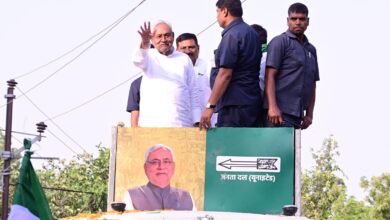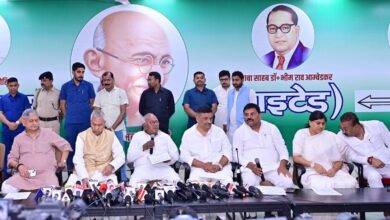
Chief Minister Nitish Kumar-led government tabled details of Bihar’s caste-based survey report in the state assembly and legislative council on November 7. The report shows that 34.13 percent of all families in Bihar survive on less than Rs 6,000 per month.
Monthly income of 29.61 percent families in the state is between Rs 6000 to Rs 10,000. So, 63.74 percent of total 2,76,68,930 families in the state earn less than Rs 10,000 per month. Only 9 percent of the households earn more than Rs 50,000 in a month. Out of the total, 16% have income in the range of Rs 20,000 to Rs 50,000, while 19% families’ monthly income is between Rs 10,000 and Rs 20,000.
Poverty is the highest among Scheduled Castes and Scheduled Tribes. 42.70 percent SC and ST households earn less than Rs 6,000 a month. The survey data shows bleak picture of poverty in the state. 33.16 percent of individuals in the Other Backward Classes (OBCs) and 33.58 percent in the Extremely Backward Classes (that is over 60 percent of the state) face poverty in Bihar and 25.09 percent of families in the General category are also poor.
Only 5.76 per cent of Scheduled Castes had finished Class 11 and Class 12. That number rises just marginally to nine per cent for all; this is significantly lower than six per cent listed in a 2017/18 National Statistical Office report.
The poverty ratio was surprisingly high for the Bhumihars (27.58), believed to be the biggest land-owning caste of Bihar, who also dominated the state’s politics until the Mandal wave of the 1990s threw up a new power structure.
Government Jobs
The survey indicated that government employees constitute just 1.57 per cent (2,049,370 individuals) of the state’s population. Of these, 6.41 lakh persons are from upper castes.
The organised sector workers make up 1.22 per cent, while unorganised sector workers represent 2.14 per cent.
According to the Bihar-caste survey report, over 6 lakh people from the General category have government jobs, which amounts to 3.19 per cent of the total population.
About 4.99 per cent of Bhumihars in Bihar have government jobs while 3.60 per cent of Brahmins in Bihar are in government jobs.
People in government jobs from Rajput and Kayasth communities in Bihar comprise 3.81 per cent and 6.68 per cent respectively.
The Sheikh community has a share of 39,595 people in government jobs, which is 0.79 per cent, while the Pathan community has a share of 10,517 individuals in government jobs, which amounts to 1.07 per cent.
Out of the total Sayyed community in Bihar, 7,231 people are in government jobs.
According to the Bihar-caste survey report, 6,21,481 people from the Backward Class category have government jobs, which amount to 1.75 per cent of the total Backward Class population in Bihar.
Around 2,89,538 people from the Yadav community have government jobs which amounts to 1.55 per cent of the total Backward Class population in Bihar.
Around 2.04 per cent of the Kushwaha community, 3.11 per cent of the Kurmi, 1.96 per cent of Tradesman, 0.63 per cent of Surjapuri Muslims, 4.21 per cent Bhaant and 1.39 per cent of Malik Muslims have government jobs.
Literacy
The caste survey report says that around 6.11 per cent of the total population, that is nearly 80 lakh persons, are graduates in Bihar. According to the report, 24,534 people belonging to Other Reported Classes (ORC) have the maximum number of graduates, accounting for 13.45 per cent of their total population.
Of the 80 lakh, a total of 26,95,820 (13.41 per cent) graduates from the general category, adding altogether there are 7,83,050 Scheduled Caste graduates, which is a meagre 3.05 per cent of their total population.
Postgraduates are 10,76,700, which is 0.82 per cent of the population and people who have a PhD and the ones who are chartered accountants are merely 0.07 per cent.
Only 9.19 per cent people (1,20,12,146) have cleared their higher secondary examination and 14.71 per cent (19,22,99,97) have passed class 10, the report added.
The overall literacy rate in the state is 79.7 per cent, according to Mr Chaudhary. “In our survey, literacy rate is 79.70 per cent. Literacy rate is higher in women (compared to) men…for every 1,000 males, there are 953 (literate) females,” he said. For context, he said this number was 918 in 2011.
Only 22.67 per cent of respondents had studied till Class 5, but this increases to 24.31 per cent for people from Scheduled Castes and 24.65 per cent for those from Extremely Backward Classes.
Among the General Category this is just 17.45 per cent.
Reservation Quota
After the data was out, CM Nitish Kumar proposed an increase the quota from 50 per cent to 65 per cent. This is excluding a 10 percent reservation for individuals from Economically Weaker Sections.
Under the proposed revised quotas, Scheduled Caste candidates will now have 20 percent, while those from OBCs and EBCs will get 43 percent – a significant increase from the earlier 30 percent.
Reservation of 2 percent has been proposed for ST candidates. “We will do the needful after due consultations. It is our intent to effect these changes in the current session,” Kumar said.
The chief minister made the statement while taking part in a debate that followed the tabling of the much-awaited economic details of the Bihar caste survey commissioned by his government.
Kayasthas most well-off
The Bihar government has categorised seven castes in the state as upper caste including four from Hindu community and three from Muslim community. The Hindu, Brahmin, Bhumihar, Rajput and Kayastha have been put under upper caste category.
The most well-off Hindu upper caste were the numerically miniscule Kayasthas, the caste survey has revealed. Only 13.83% of families from the largely urbanised community were poor. The report states that there are 52,490 Kayasthas of which 6.68% have government jobs
The poverty ratio was surprisingly high for the Bhumihars (27.58), believed to be the biggest land-owning caste of Bihar, who also dominated the state’s politics until the Mandal wave of the 1990s threw up a new power structure. Bhumihars are at the second position as far as government jobs are concerned. At least 4.99% of them have government jobs, which is nearly about 2 lakh people.
The population of Rajputs is also about 2 lakh and nearly 3.81% of them have government jobs.
Muslim upper castes
The Muslim upper castes include the Sheikhs, Pathans and the Sayyads. Among Muslim upper castes, 39,595 people of Sheikh caste have government jobs which is 0.79% of their actual population.
As far as Pathans are concerned, 10,517 people have government jobs which is 1.07% of the total population. Meanwhile, at least 7,231 people from the Sayyad caste have government jobs which is 2.42% of their total population.




